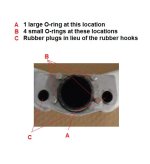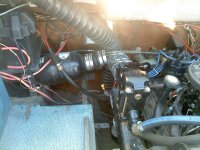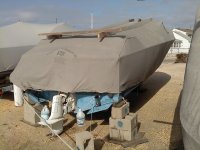Walleye4Days
Contributing Member
At the end of the season (thanks to Rick and the rest of the guys here!) I got my thru hull exhausts rigged in and going well. I temporarily left the exhaust y-pipe in place to not have to remove the engine a 3rd time and just plugged it with a 3" plumbing plug aft of the transom, and two fernco caps fore of the transom of cut ends the y-pipe themselves. Worked great for the rest of season and well into December.
Now, I'm pulling the engine and have the y-pipe out. But, I'm having trouble deciding how to deal off the stock exhaust hole because of the two exhaust relief holes are right up against curved parts of the transom shield... I have the power trim version AQ280, so it doesn't have just the exhaust port or the exhaust port and single relief. Both reliefs are extremely close the edges where it begins to curve, and the normal blockoff plates just aren't available for it.
Do I have to pay a Tig welder to get in there and weld the plate on, or should I just make my own plate for the aft side and 5200 inbetween, or what is the best approach and option to sealing this off very effectively and without future worry? (I go 15-20miles out on Lake Erie, so definitely don't want to risk any leaking or the corners seeping hear those relief holes because of how thin the sealing margin would be from around the edges first left and right on them). Any advice or suggestions?
Now, I'm pulling the engine and have the y-pipe out. But, I'm having trouble deciding how to deal off the stock exhaust hole because of the two exhaust relief holes are right up against curved parts of the transom shield... I have the power trim version AQ280, so it doesn't have just the exhaust port or the exhaust port and single relief. Both reliefs are extremely close the edges where it begins to curve, and the normal blockoff plates just aren't available for it.
Do I have to pay a Tig welder to get in there and weld the plate on, or should I just make my own plate for the aft side and 5200 inbetween, or what is the best approach and option to sealing this off very effectively and without future worry? (I go 15-20miles out on Lake Erie, so definitely don't want to risk any leaking or the corners seeping hear those relief holes because of how thin the sealing margin would be from around the edges first left and right on them). Any advice or suggestions?





